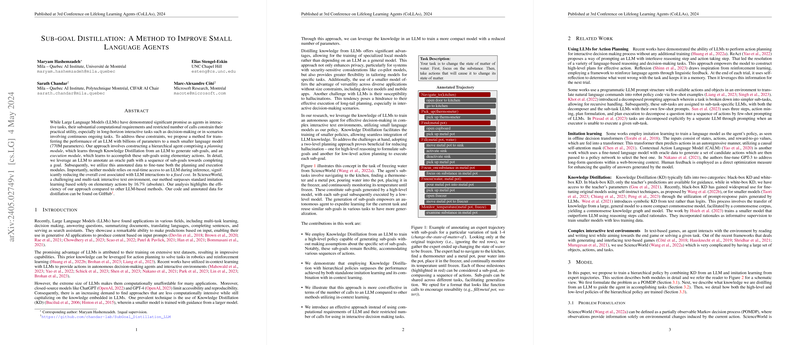Simplifying LLMs for Interactive Tasks Using Hierarchical Agents and Knowledge Distillation
Overview of the Dual Module Approach
The research focuses on an innovative way of utilizing LLMs for complex interactive tasks without incurring high computational costs. By distilling knowledge from an LLM into a much smaller model, the paper leverages a two-part system comprising a planning module and an execution module, designed to work in tandem to address intricate problems efficiently.
The Mechanism Behind the Model
The system operates through a hierarchical structure:
- Planning Module: This component functions as a high-level policy maker, utilizing a smaller, distilled version of an LLM to create sub-goals essential for solving a task. These sub-goals outline what needs to be achieved step-by-step, providing a clear path forward.
- Execution Module: Acting as a low-level policy executor, this module focuses on achieving the sub-goals laid out by the planning module using direct actions.
How It Works
- The LLM generates a sequence of sub-goals by analyzing an oracle path toward task completion.
- These sub-goals and their corresponding elementary actions are used to fine-tune the planning and execution modules.
- Notably, real-time access to the LLM isn't needed after these modules are fine-tuned, which drastically cuts down the ongoing computational costs.
Significant Results Highlighted
The integration of this hierarchical agent design delivers commendable results:
- In ScienceWorld, an environment known for its complexity, this method surpassed traditional imitation learning performances by a notable margin of 16.7%.
- It showcases efficiency not only in computational resources but also in the flexibility and applicability across various scenarios without continuous LLM dependency.
Practical Implications
Cost Efficiency
By reducing dependency on LLM queries during runtime, the model addresses significant cost constraints, making it viable for longer-term or continuous interactive tasks that would otherwise be computationally prohibitive.
Task-Specific Adaptation
The modular nature of the smaller LLMs allows for adjustments tailored to specific tasks, enhancing both performance and applicability in diverse applications, from mobile apps to embedded systems in robotics.
Theoretical Implications
The use of Knowledge Distillation (KD) to transfer intricate decision-making capabilities from a large model to a smaller one could open new avenues in AI training methodologies. This approach illustrates how distilled models could potentially retain or even enhance the decision-making prowess of their progenitors without bearing the same operational costs.
Speculating on Future Developments
As AI continues to evolve, models like these could lead to more sustainable and economical AI deployments in environments where continuous learning and interaction are required. Further refinement could lead to models that can dynamically adjust their goals based on changing circumstances, enhancing their decision-making abilities in real-time.
Continued advances in KD techniques may allow even smaller models to perform tasks previously thought only manageable by significantly larger systems, broadening the scope of AI's applicability in resource-constrained settings.
Conclusion
This paper provides a compelling look at how hierarchical agent structures and knowledge distillation can effectively reduce the reliance and computational demand of LLMs in complex interactive environments. The promising results not only bolster the case for more cost-effective AI models but also open intriguing possibilities for future research in AI efficiency and adaptability.
